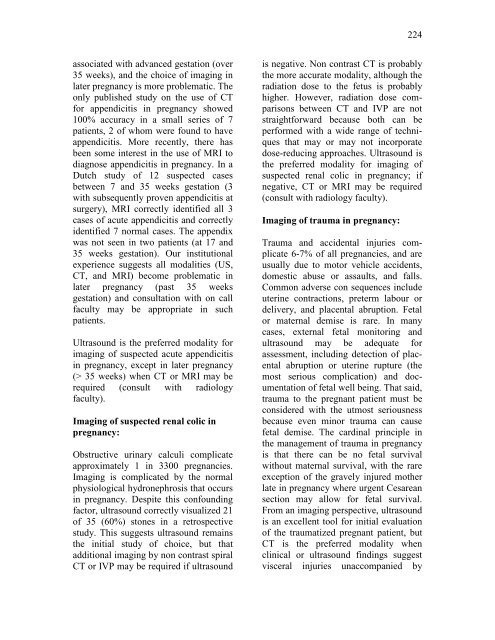Book of Medical Disorders in Pregnancy - Tintash
Book of Medical Disorders in Pregnancy - Tintash
Book of Medical Disorders in Pregnancy - Tintash
Create successful ePaper yourself
Turn your PDF publications into a flip-book with our unique Google optimized e-Paper software.
associated with advanced gestation (over<br />
35 weeks), and the choice <strong>of</strong> imag<strong>in</strong>g <strong>in</strong><br />
later pregnancy is more problematic. The<br />
only published study on the use <strong>of</strong> CT<br />
for appendicitis <strong>in</strong> pregnancy showed<br />
100% accuracy <strong>in</strong> a small series <strong>of</strong> 7<br />
patients, 2 <strong>of</strong> whom were found to have<br />
appendicitis. More recently, there has<br />
been some <strong>in</strong>terest <strong>in</strong> the use <strong>of</strong> MRI to<br />
diagnose appendicitis <strong>in</strong> pregnancy. In a<br />
Dutch study <strong>of</strong> 12 suspected cases<br />
between 7 and 35 weeks gestation (3<br />
with subsequently proven appendicitis at<br />
surgery), MRI correctly identified all 3<br />
cases <strong>of</strong> acute appendicitis and correctly<br />
identified 7 normal cases. The appendix<br />
was not seen <strong>in</strong> two patients (at 17 and<br />
35 weeks gestation). Our <strong>in</strong>stitutional<br />
experience suggests all modalities (US,<br />
CT, and MRI) become problematic <strong>in</strong><br />
later pregnancy (past 35 weeks<br />
gestation) and consultation with on call<br />
faculty may be appropriate <strong>in</strong> such<br />
patients.<br />
Ultrasound is the preferred modality for<br />
imag<strong>in</strong>g <strong>of</strong> suspected acute appendicitis<br />
<strong>in</strong> pregnancy, except <strong>in</strong> later pregnancy<br />
(> 35 weeks) when CT or MRI may be<br />
required (consult with radiology<br />
faculty).<br />
Imag<strong>in</strong>g <strong>of</strong> suspected renal colic <strong>in</strong><br />
pregnancy:<br />
Obstructive ur<strong>in</strong>ary calculi complicate<br />
approximately 1 <strong>in</strong> 3300 pregnancies.<br />
Imag<strong>in</strong>g is complicated by the normal<br />
physiological hydronephrosis that occurs<br />
<strong>in</strong> pregnancy. Despite this confound<strong>in</strong>g<br />
factor, ultrasound correctly visualized 21<br />
<strong>of</strong> 35 (60%) stones <strong>in</strong> a retrospective<br />
study. This suggests ultrasound rema<strong>in</strong>s<br />
the <strong>in</strong>itial study <strong>of</strong> choice, but that<br />
additional imag<strong>in</strong>g by non contrast spiral<br />
CT or IVP may be required if ultrasound<br />
224<br />
is negative. Non contrast CT is probably<br />
the more accurate modality, although the<br />
radiation dose to the fetus is probably<br />
higher. However, radiation dose comparisons<br />
between CT and IVP are not<br />
straightforward because both can be<br />
performed with a wide range <strong>of</strong> techniques<br />
that may or may not <strong>in</strong>corporate<br />
dose-reduc<strong>in</strong>g approaches. Ultrasound is<br />
the preferred modality for imag<strong>in</strong>g <strong>of</strong><br />
suspected renal colic <strong>in</strong> pregnancy; if<br />
negative, CT or MRI may be required<br />
(consult with radiology faculty).<br />
Imag<strong>in</strong>g <strong>of</strong> trauma <strong>in</strong> pregnancy:<br />
Trauma and accidental <strong>in</strong>juries complicate<br />
6-7% <strong>of</strong> all pregnancies, and are<br />
usually due to motor vehicle accidents,<br />
domestic abuse or assaults, and falls.<br />
Common adverse con sequences <strong>in</strong>clude<br />
uter<strong>in</strong>e contractions, preterm labour or<br />
delivery, and placental abruption. Fetal<br />
or maternal demise is rare. In many<br />
cases, external fetal monitor<strong>in</strong>g and<br />
ultrasound may be adequate for<br />
assessment, <strong>in</strong>clud<strong>in</strong>g detection <strong>of</strong> placental<br />
abruption or uter<strong>in</strong>e rupture (the<br />
most serious complication) and documentation<br />
<strong>of</strong> fetal well be<strong>in</strong>g. That said,<br />
trauma to the pregnant patient must be<br />
considered with the utmost seriousness<br />
because even m<strong>in</strong>or trauma can cause<br />
fetal demise. The card<strong>in</strong>al pr<strong>in</strong>ciple <strong>in</strong><br />
the management <strong>of</strong> trauma <strong>in</strong> pregnancy<br />
is that there can be no fetal survival<br />
without maternal survival, with the rare<br />
exception <strong>of</strong> the gravely <strong>in</strong>jured mother<br />
late <strong>in</strong> pregnancy where urgent Cesarean<br />
section may allow for fetal survival.<br />
From an imag<strong>in</strong>g perspective, ultrasound<br />
is an excellent tool for <strong>in</strong>itial evaluation<br />
<strong>of</strong> the traumatized pregnant patient, but<br />
CT is the preferred modality when<br />
cl<strong>in</strong>ical or ultrasound f<strong>in</strong>d<strong>in</strong>gs suggest<br />
visceral <strong>in</strong>juries unaccompanied by


